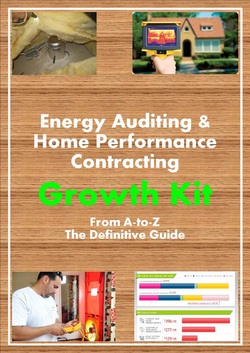FREE HERS RATER PRACTICE EXAMPUT YOUR HOME PERFORMANCE BUSINESS ON ROCKET FUEL |
COMMUNICATING TO YOUR CREWLet's face it, we all want to have a successful home performance or energy auditing company. From an auditors point of view the better you can do your audits (which includes communication to the crew), the more sought out you will become and the more money you can demand for your services. If you are running a home performance crew, the faster your team can complete the job with zero call backs, high customer satisfaction and excellent quality, the faster you will get promoted to a project manager and the more money you can make. For small business owners, the better you can train your auditors and crew to work together, the less headaches you will have and better more time you can focus on bringing in more business. For anyone in this industry, clear communication to your crew is essential. I want to give you some tips I've picked up over the years to help grow my business, put more equity in my business, get me out of the attics, and essentially reproduce myself.
Essential Audit DetailsWant a higher pay per audit? Want to be well known in your region for performing awesome audits by both homeowners and home performance contractors? Here is what you should be doing.
Essentials for a Successful Crew
Next Section |
ENERGY AUDITOR NEWSLETTERGet the only Energy Auditor Marketing Newsletter with monthly strategies and tactics to grow your home performance business.
|
- HOME
- HERS PRACTICE EXAMS
- NEWBIES
-
STUDY GUIDES
-
HERS RATER WRITTEN EXAM
>
-
Section 1 Building Science Fundamentals
>
-
1a. Basic Terms & Definitions
>
- 1. Airflow in Buildings
- 2. Equipment Efficiencies
- 3. Power and Energy
- 4. Effective Leakage Area
- 5. Area Weighted R-Value
- 6. Baseload / Seasonal Energy Use
- 7. Driving Forces (Including Natural and Mechanical)
- 8. Behavior of Radiation
- 9. Thermal Resistance / Transmittance: R and U Values
- 10. Latent / Sensible Heat
- 11. Total Equivalent Length
- 12. Dehumidification / Humidification
- 13. Convert Pressure Units
- 14. Thermal Bridges
- 15. Pressure Boundary
- 16. Stack Effect
- 17. Exfiltration and Infiltration
- 18. Natural / Mechanical Ventilation
- 19. Net Free Area
- 20. Input & Output Capacity
- 21. Peak Electrical Demand
- 22. Permeability and Perm Rating
- 23. Standby Loss
- 24. IAQ (indoor air quality): Moisture, CO, Dust
-
1b. Principals of Energy, Air & Moisture Thermodynamics
>
- 1. Thermodynamics: Conduction, Convection, Radiation, ΔT
- 2. Factors That Affect Insulation Performance
- 3. House Pressurization/Depressurization by Various Forces
- 4. Heat Gain / Loss
- 5. Power and Energy
- 6. Moisture Transport Mechanisms
- 7. Identify Areas of Highest Relative Humidity
- 8. Principles of Combustion
- 1c. Combustion Safety >
-
1a. Basic Terms & Definitions
>
-
Section 2 Buildings and Their Systems
>
-
2a. Building Components
>
- 1. Identify basic duct configurations and components
- 2. Identify Basic Hydronic Distribution Configurations and Components
- 3. Identify Basic Structural Components of Residential Construction
- 4. Thermal Boundaries and Insulation Applications
- 5. Basic Electrical Components and Safety Considerations
- 6. Basic Fuel Delivery Systems and Safety Considerations
- 7. Basic bulk water management components (drainage plumbing gutters sumps etc)
- 8. Vapor barriers/retarders
- 9. Radiant Barrier Principles and Installations
- 10. Understand Fenestration Types and Efficiencies
- 11. Understand Issues Involved With Basements, Crawlspaces, Slabs, Attics, Attached Garages, Interstitial Cavities, and Bypasses
- 12. Understand Issues Involved With Ventilation Equipment
- Understand Basic Heating / Cooling Equipment Components Controls and Operation
- Understand Basic DHW Equipment Components Controls and Operation
- Identify Common Mechanical Safety Controls
- Identify Insulation Types and R-Values
- Understand Various Mechanical Ventilation Equipment and Strategies: Spot, ERV, HRV
-
Conservation Strategies
>
- Appropriate Insulation Applications and Installation Based On Existing Conditions
- Opportunity for ENERGY STAR Lighting and Appliances
- Identify Duct Sealing Opportunities and Applications
- Understand Importance of Air Leakage Control and Remediation Procedures
- Blower Door-Guided Air Sealing Techniques
- Water Conservation Devices and Strategies
- Domestic Hot Water (DHW) Conservation Strategies
- Heating & Cooling Efficiency Applications
- Proper Use of Modeling to Determine Heating and Cooling Equipment Sizing and Appropriate Energy
- Understand the Use of Utility History Analysis in Conservation Strategies
- Appropriate Applications For Sealed Crawlspaces Basements and Attics
- Identify / Understand High Density Cellulose
- Appropriate Applications for Fenestration Upgrades Including Modification or Replacement
- Comprehensive Building Assessment Process >
-
Design Considerations
>
- Appropriate Insulation Applications Based On Existing Conditions
- Understand Fire Codes as Necessary to Apply Home Performance in a Code-Approved Manner
- Understand / Recognize Building Locations Where Opportunities for Retrofit Materials
- Understand Climate Specific Concerns
- Understand Indoor Environment Considerations for the Environmentally Sensitive
- Understand Impact of Building Orientation, Landscape Drainage, and Grading
- Opportunity Potential Renewable Energy Applications: Geothermal, Photovoltaic, Wind
- Understand Impact of Shading on Heating / Cooling Loads
- Awareness for Solar Gain Reduction / Solar Gain Opportunities
- Understand Need for Modeling Various Options For Efficiency Upgrades
-
2a. Building Components
>
-
Measurement & Verification of Building Performance
>
-
Measurement & Verification of Building Performance
>
- Air Leakage Test Results
- Understand Building Shell / Envelope Leakage
- Apply Fundamental Construction Mathematics and Unit Conversions
- Calculate Building Tightness Levels (Minimum Ventilation Requirements)
- Calculate Heating Degree Days and Cooling Degree Days
- Identify Proper Appliance and Combustion Appliance Venting
- Ventilation calculations and strategies
- Proper methods for identifying / testing fuel leaks
- Blower door setup, accurate measurement and interpretation of results
- Combustion Appliance Zone (CAZ): depressurization, spillage, draft, Carbon Monoxide (ambient and flue)
- Carbon Monoxide (CO) evaluation: ambient
- Proper applications and use of temperature measuring devices
- Pressure pan and room to room pressure diagnostics
- Recognize contributing factors to comfort problems
- Inspect for areas containing moisture or bulk water in undesirable locations
- Understand and inspect for basic electric safety (e.g. frayed wires, open boxes, etc)
-
Measurement & Verification of Building Performance
>
-
RESNET HERS RATER National Standards & Project Specifications
>
- Understand applicability content and intent of BPI National Standards – Do no harm, make buildings more healthy, comfortable, durable and energy efficient
- Recognize need for a professional local/state/national codes evaluation
- Be able to specify appropriate materials and processes needed for building performance projects
- Analyzing Buildings Systems >
- Conduct and Communications >
-
Section 1 Building Science Fundamentals
>
- HERS RATER FIELD EXAM >
- BLOWER DOOR TEST >
- RESNET STANDARDS >
-
HERS RATER WRITTEN EXAM
>
- ESSENTIALS
- AFTER THE EXAM
- NEWSLETTER


